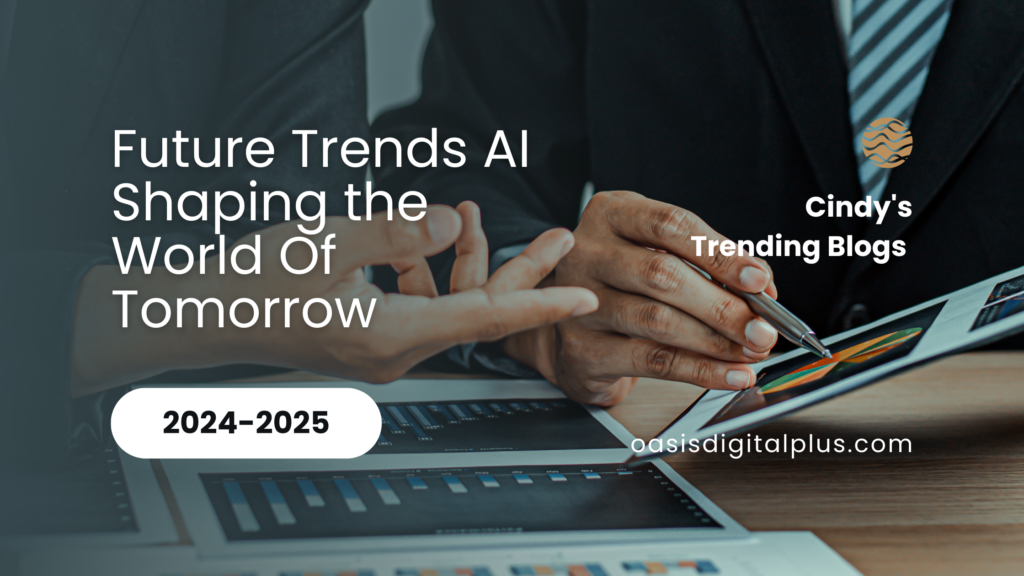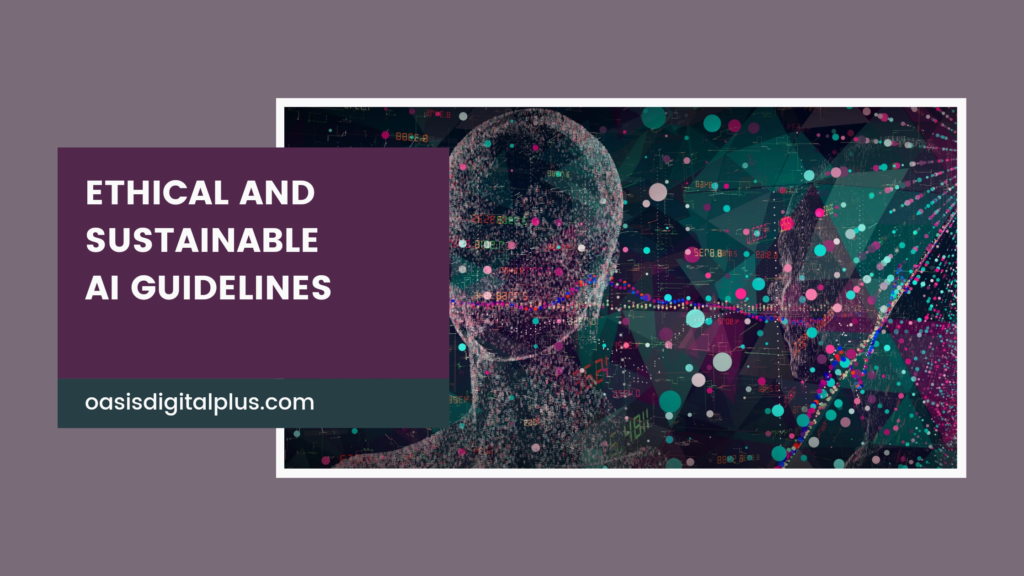Address
304 North Cardinal
St. Dorchester Center, MA 02124
Work Hours
Monday to Friday: 7AM - 7PM
Weekend: 10AM - 5PM
Address
304 North Cardinal
St. Dorchester Center, MA 02124
Work Hours
Monday to Friday: 7AM - 7PM
Weekend: 10AM - 5PM


Artificial Intelligence (AI) has rapidly evolved from a futuristic concept to a transformative force reshaping industries, economies, and daily life. As we look to the future, AI’s potential continues to expand, promising even greater innovations and disruptions. This article explores the key trends that will define the future of AI, highlighting their implications, opportunities, and challenges.
1. AI and Healthcare: A Revolution in MedicineAI is set to revolutionize healthcare, offering advancements in diagnosis, treatment, and patient care.
a. Precision Medicine: AI algorithms analyze genetic information, lifestyle data, and environmental factors to offer personalized treatment plans. This approach enhances the efficacy of treatments and reduces adverse effects.
b. Early Diagnosis: Machine learning models can detect diseases at early stages by analyzing medical images and patient data. AI systems have shown remarkable accuracy in diagnosing conditions like cancer, diabetic retinopathy, and cardiovascular diseases.
c. Drug Discovery: AI accelerates drug discovery by predicting molecular structures that can interact with disease targets. This significantly reduces the time and cost involved in bringing new drugs to market.
d. Virtual Health Assistants: AI-powered virtual assistants provide 24/7 support, answering patient queries, scheduling appointments, and monitoring chronic conditions. This enhances patient engagement and reduces the burden on healthcare professionals.

2. AI in Finance: Transforming the Financial LandscapeThe financial industry is leveraging AI to enhance efficiency, improve security, and deliver personalized services.
a. Fraud Detection: AI algorithms detect fraudulent activities by analyzing transaction patterns in real-time. This helps financial institutions prevent fraud and protect customer assets.
b. Algorithmic Trading: AI-driven trading systems analyze vast amounts of data to make investment decisions at high speed and accuracy. This results in better market predictions and optimized investment strategies.
c. Personal Finance Management: AI-powered apps provide personalized financial advice, helping individuals manage budgets, savings, and investments. These tools offer insights based on spending habits and financial goals.
d. Risk Management: AI models assess credit risk, market risk, and operational risk by analyzing historical data and current trends. This enables financial institutions to make informed decisions and maintain stability.

3. AI in Autonomous Vehicles: Driving the FutureThe development of autonomous vehicles (AVs) is one of the most exciting applications of AI, promising safer and more efficient transportation.
a. Enhanced Safety: AI systems in AVs use sensors, cameras, and machine learning to navigate roads, avoid obstacles, and make split-second decisions. This reduces the likelihood of human error, which is a leading cause of accidents.
b. Traffic Management: AI optimizes traffic flow by analyzing data from connected vehicles and traffic signals. This reduces congestion, lowers emissions, and improves travel times.
c. Ride-Sharing and Delivery: Autonomous ride-sharing and delivery services are becoming more viable, offering cost-effective and convenient transportation and logistics solutions.
d. Integration with Smart Cities: AVs will play a crucial role in smart city ecosystems, interacting with infrastructure to enhance urban mobility and sustainability.

4. AI and the Internet of Things (IoT): Creating Smart Ecosystems
The integration of AI with IoT is creating interconnected ecosystems that enhance efficiency, convenience, and quality of life.
a. Smart Homes: AI-enabled devices in smart homes automate tasks, monitor security, and manage energy usage. For instance, AI-powered thermostats learn user preferences to optimize heating and cooling.
b. Industrial IoT: In manufacturing, AI analyzes data from IoT sensors to predict equipment failures, optimize maintenance schedules, and improve operational efficiency.
c. Smart Agriculture: AI-driven IoT solutions in agriculture monitor soil conditions, weather patterns, and crop health. This enables precision farming, which increases yield and reduces resource consumption.
d. Healthcare IoT: Wearable devices and sensors collect health data, which AI analyzes to provide insights into patient health, predict potential issues, and recommend preventative measures.

5. AI and Natural Language Processing (NLP): Enhancing CommunicationAdvancements in NLP are making human-machine interactions more natural and intuitive.
a. Conversational AI: AI-powered chatbots and virtual assistants offer more accurate and context-aware responses, improving customer service and user experience.
b. Real-Time Translation: AI-driven translation services break down language barriers by providing real-time, accurate translations, facilitating global communication.
c. Sentiment Analysis: NLP algorithms analyze text from social media, reviews, and surveys to gauge public sentiment. This helps businesses understand customer opinions and tailor their strategies.
d. Content Generation: AI systems generate coherent and contextually relevant content for various applications, from news articles to creative writing. This enhances productivity and content diversity.

6. Ethical AI: Addressing Bias and FairnessAs AI becomes more integrated into society, addressing ethical concerns is paramount.
a. Reducing Bias: AI systems must be designed to minimize biases in their training data and algorithms. Ensuring fairness and equity in AI outcomes is crucial for societal trust.
b. Transparency and Explainability: AI models should be transparent and explainable, allowing users to understand how decisions are made. This is particularly important in critical applications like healthcare and finance.
c. Privacy Protection: AI systems must adhere to stringent data privacy regulations and protect user information. Developing privacy-preserving AI techniques is essential for maintaining public trust.
d. Ethical Guidelines: Establishing and following ethical guidelines for AI development and deployment is necessary to prevent misuse and ensure that AI benefits all of society.

7. AI in Education: Personalizing Learning- Ai is transforming education by offering personalized learning experiences and enhancing administrative efficiency.
a. Adaptive Learning: AI-powered platforms adjust learning materials based on individual student needs and performance. This ensures that each student receives a tailored education experience.
b. Automated Grading: AI automates grading, providing immediate feedback and reducing the administrative burden on educators.
c. Intelligent Tutoring Systems: AI tutors provide personalized instruction and support, helping students understand complex concepts and improve their skills.
d. Administrative Efficiency: AI streamlines administrative tasks such as scheduling, enrollment, and resource allocation, allowing educators to focus more on teaching.

8. Future Workforce: AI and Human Collaboration AI is reshaping the workforce, emphasizing collaboration between humans and machines.
a. Augmented Intelligence: AI tools enhance human capabilities, allowing workers to perform tasks more efficiently and creatively. This collaboration leads to higher productivity and innovation.
b. Reskilling and Upskilling: The rise of AI requires workers to acquire new skills. Organizations must invest in training programs to help employees adapt to AI-driven workflows.
c. New Job Roles: AI will create new job roles that focus on managing, developing, and maintaining AI systems. These roles will require a blend of technical and domain-specific expertise.
d. Ethical Workforce Management: Companies must address ethical considerations related to AI in the workplace, ensuring fair treatment and opportunities for all employees.
The future of AI is filled with transformative potential and exciting possibilities. From revolutionizing healthcare and finance to enhancing education and transportation, AI will continue to shape the world in profound ways. However, as we embrace these advancements, it is crucial to address the ethical, social, and economic challenges that arise. By fostering collaboration between humans and machines, promoting transparency and fairness, and investing in education and reskilling, we can harness the power of AI to build a better, more equitable future.The journey into the future of AI is just beginning, and the innovations we will witness in the coming years are likely to surpass our wildest imaginations. As we navigate this dynamic landscape, a balanced and thoughtful approach will be key to unlocking the full potential of AI for the benefit of all humanity.